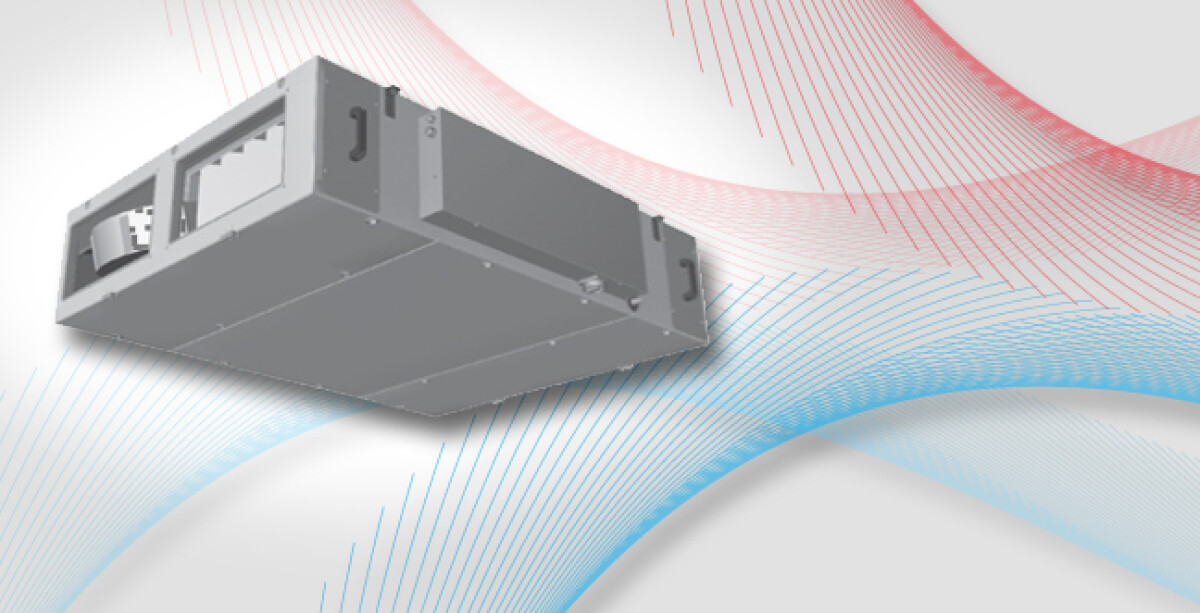Aventis XS-FLAT-90-RO, the new heat recovery unit

In the middle of this year 2VV will bring a new heat recovery unit to the market under the name XS-FLAT-90-RO. This product will expand on and continue on from its portfolio of the ever increasingly demanded and technologically growing HRU area. The unit has been developed with an emphasis on saving-energy operation, utility and comfort functions for the user and a wide selection of project solutions meeting the individual requirements at building sites. To simplify the selection of an appropriate unit, it is possible to use the ventilation and heat recovery unit design program located at www.2vv.cz.
The XS-FLAT-90-RO is an under the ceiling heat recovery unit offering, thanks to its parameters, a wide range of applications namely in the business segment. It is produced in three basic sizes covering air power from 800 to 2500 m3/h. Thanks to its minimal build-in height from 350 to 490mm, we can consider it to be the widest performance line of under the ceiling heat recovery units especially suitable for installation into dropped ceilings (including existing ones). The minimum build-in height is definitely not achieved at the cost of the thickness of the unit´s casing, which in all three units is 30 mm.
The XS-FLAT-90-RO unit certainly has a lot to offer into an environment where today´s trends ever increasingly focus on savings and reduction of building energy demands as well as the installation of essential economical HVAC systems. The heart of the unit is an aluminium conterflow heat recovery exchanger that, thanks to its unique 2VV SWIRL CHAMBER SYSTEM technology, offers up to 90% efficiency. Maximum heat recovery utilisation in all climatic conditions is delivered via a continuous fully automatic by-pass. Thanks to the energy saving EC motors from EBM the heat recovery unit has a very low SFP (Specific fan power) value of 0.19 W/m3h-1. The XS-FLAT-90-RO was designed with energy savings in mind not only during the actual operation of the unit, but also during the STAND-BY mode, where the unit is not running and is ready for immediate start up. The power consumption during this STAND-BY mode is a mere 1W.
The intuitive and user friendly controls of the unit in the form of a Touch screen controller ensure maximum comfort for all users. The touch screen controller is fully utilised also during the first setup and start up of the unit. The Touch screen controller has an installation wizard to guide the user through the installation procedure making it a manageable process even for everyday users. The sophisticated regulation with the option to connect to a BMS (building management system) via the RS485-Modbus protocol makes it possible to use the unit for MONO (CAV) and MULTI (VAV, DCV) zone ventilation. In the automatic mode the XS-FLAT-90-RO unit is controlled by CO2, RH or cigarette smoke sensors, which are a part of the product´s optional accessories.
Detailed technical information is available in the technical catalogue datasheet.
CAV (Constant Air Volume)
Ventilation at a constant air flow rate. The ventilation unit maintains the required constant air flow rate. Even in situations where there is an increased pressure loss in the ventilation duct system the ventilation unit attempts to maintain constant air power. Increased pressure losses may be caused by, for example, clogged filters.
This system is suitable for ventilating a single room, where it is necessary to maintain a constant air supply. This is known as mono-zone ventilation
If the CAV is used for ventilating more rooms and a part of the ventilation duct system is closed, the unit still maintains the constant air power. In such a case the air from the closed section of the air conditioning duct system is divided into the opened parts of the air conditioning duct system, causing an increased air supply to the opened parts of the given system.
VAV (Variable Air Volume)
Ventilation at a constant pressure in the ventilation duct system. The ventilation unit maintains a constant pressure. If pressure loss increases the unit reduces the air power in order to achieve the required pressure in the ducts. Increased pressure losses may be caused by, for example, some part of the ventilation duct system being closed. In such a case the pressure loss is increased and the ventilation unit reduces its power. Thereby the air supply into the remaining open ventilation duct system remains unchanged. When the ventilation duct is opened the pressure loss is reduced and the ventilation unit reacts by increasing the air power in order to archive the required pressure in the ducts and to again supply the newly opened section of the ventilation duct system with air.
This system is suitable for ventilating multiple rooms, where it is necessary to maintain a constant air supply to individual rooms independently of the conditions in the remainder of the air conditioning duct system. This is known as multiple-zone ventilation
DCV (Demand Controlled Ventilation)
Ventilation controlled by air quality demands. This is a VAV system with the addition of a continuously adjustable flap (VAV flaps) located on the air inlet duct going into the ventilated room. Every VAV flap is fitted with an AQS (Air Quality Sensor), which on the basis of an air quality measurement continuously regulates the opening of the VAV flap. This function makes it possible to continuously regulate the requirement of maintaining air quality in the ventilated room. If the AQS (CO2, RH, SMOKE sensor...) measures lower air quality values, it opens the VAV flap and provides sufficient air supply so as to maintain air quality at the required level. Conversely if the AQS sensor measures good air quality (there is no need for ventilation), the VAV flap is closed and the room is ventilated only with minimum air supply, which saves energy expended on ventilation.
The ventilation unit on this system reacts to changes in pressure in the ventilation duct system in the same way as the VAV system. However, the air power of the ventilation unit is directly proportional to air quality in the ventilated rooms.
This system is appropriate for ventilating multiple rooms, where it is necessary to maintain air quality in individual rooms, independently of the conditions in the other ventilated rooms and maintaining energy consumption at the lowest possible level. This is known as multiple-zone ventilation with monitoring of air quality and energy consumption.




